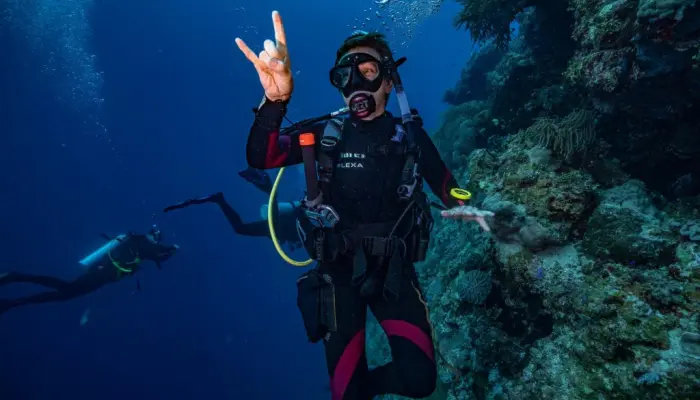If you're contemplating getting a scuba diving certification, this guide will help you understand the different options available. In this guide, we will look at the three largest scuba diving certification systems and their differences, but it’s important to know that our tours exclusively use PADI centers.
Once you obtain a scuba diving certification, you’ll be trained to dive up to 18 meters deep anywhere in the world.
It's crucial to understand that a scuba diving certification is just an entry point into the underwater world, where you'll learn basic skills. The real training starts later, as you gain experience through numerous dives.
The certification course usually lasts 3-5 days. After completing it, you can begin exploring the vast underwater world - and the best part is that your scuba diving certification is valid globally. This is an excellent way to have unforgettable experiences. For instance, you can rent diving equipment at any dive center worldwide and participate in dive tours. Most newly certified divers go on dive tours, gaining new experiences and accumulating dives in their logbooks. Those who wish to pursue diving more seriously opt for liveaboards.
Liveaboards are dive tours where you live on a boat for a period and dive 3-4 times a day during the trip. This is a surefire way to have fantastic diving experiences.
You can earn your scuba diving certification during any of our dive tours.
Who Issues Scuba Diving Certifications
PADI (Professional Association of Diving Instructors)
Founded in the USA in 1966, PADI is the largest and most authoritative diving certification organization in the world. PADI boasts over 137,000 affiliated diving instructors and 6,600 dive centers and resorts globally.
SSI (Scuba Schools International)
SSI is the world's second most popular diving certification organization, founded in the USA in 1970. SSI has more than 2,800 affiliated dive centers globally.
CMAS (World Confederation of Underwater Activities)
CMAS is the largest body uniting diving organizations, with over 130 sports federations for underwater activities. The major distinction of CMAS courses is that they require significantly more time to complete. While PADI and SSI courses typically last 3-5 days, CMAS programs can span several months.
PADI Open Water Diver Course (Scuba Diving Certification)
As we exclusively use PADI centers in our tours, we will focus on what's included in the PADI course. The PADI Open Water Diver course consists of three elements:
- Theory - (5 modules and an exam). This part can be completed at home through an online e-learning course or on-site with the PADI textbook.
- Confined Water - (5 modules, e.g., in a swimming pool). Here, you'll learn the basic skills necessary for diving.
- Open Water - (4 sea dives). Now, you'll begin the most exciting part and make your first real sea dives.
The duration of the PADI course depends on the program's intensity. Typically, it takes five days to complete the PADI Open Water Diver course:
- 2 days for theory (if not completed at home).
- 1 day for Confined Water.
- 2 days for Open Water dives (2 dives per day).
Requirements for Obtaining a Scuba Diving Certification
You must be at least 12 years old (children aged 10-15 can only obtain the PADI Junior Open Water certificate. If the child is under 15, a parent must participate. The Junior certificate automatically upgrades to the adult certificate upon turning 15).
You must be in good general health and complete the PADI medical questionnaire. If you answer "yes" to any question on the first page, you must undergo a medical examination by a doctor, who will complete and sign the second page.
You must be able to swim 200 meters (or 300 meters with fins and a snorkel) and float or tread water for 10 minutes.
Skip the Boring Part at Home
If you find theory and confined water dives during your vacation boring, you can take the Open Water Diver Referral course. In this course, you learn theory and practice in confined water at home, then complete the course with open water dives during your trip.
